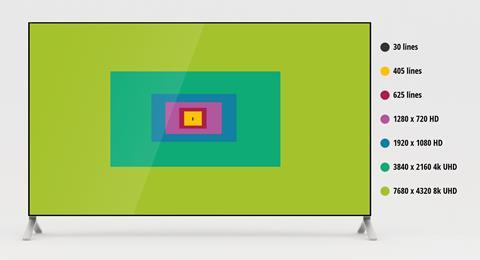Darren Deans, media and broadcast marketing specialist, explores the evolution of television resolution

You’ve probably noticed the acronyms next to streaming options on Netflix, BBC iPlayer, or Prime Video: SD, HD, UHD, 4K, and even 8K. They also appear on TVs and mobile devices. But what do these labels actually mean, and how do they affect the shows we love to watch?
To understand their significance, we need to rewind 100 years. In 1925, John Logie Baird gave the first public demonstration of televised silhouette images in motion at Selfridges department store in London — a humble beginning for what would become one of the most transformative technologies in the world.
The dawn of television: from 30 to 625 lines
Television as we know it began humbly. In the early 1930s, the BBC began experimenting with television broadcasting using a crude 30-line system developed by TV pioneer John Logie Baird. That number refers to how many vertical scan lines made up the picture on screen. It was not nearly enough to create even a half-decent picture – it was barely enough resolution to make out a human face. It was also in a portrait format, with an aspect ratio of 3:7 (width:height), rather like a TikTok video today.
This system marked the beginning of how we describe television quality — by counting how many lines (or pixels) make up the image. The more lines (or pixels), the clearer and more detailed the picture.
In 1936, the BBC launched its regular television service with a significant upgrade on its early experiments. The BBC switched to a 405-line system, broadcast in an aspect ratio of 5:4 (until it changed to the more common 4:3 format in 1950).
The 405-line system, developed by Marconi-EMI, was officially described as “high definition.” Yes, the phrase “HD” that we now associate with super-sharp, modern displays was first used back in the 1930s to describe an image with just 405 lines. The decision to adopt this new standard, as legend has it, was made over a Sunday lunch — a fittingly British origin for a major technological leap.
This 405-line standard remained the backbone of British television until the 1960s.
In 1964, the BBC launched BBC2 with a new 625-line system, which was the European standard of the time. It offered a noticeable improvement in picture quality and paved the way for colour broadcasts. But viewers had to get a new television and aerial to watch it, so the old 405-line transmissions continued for another two decades.
By this time, television had become a central fixture in most households, and viewers had come to expect better quality images — setting the stage for the digital revolution.
The rise of digital broadcasting: enter HD
In 1998, digital terrestrial and digital satellite television was launched in the UK. It initially broadcast in what we now call standard definition (SD), with a similar quality to the traditional 625-line format.
Then in 2007, the UK began switching from analogue to digital broadcasting in earnest, a process completed by 2012. The BBC, for example, launched BBC HD in 2007, the first free-to-air, high-definition television channel in the UK.
Digital signals allowed for better picture quality, more channels and more efficient use of the broadcast spectrum.
With digital HD, we moved away from counting just scan lines. Instead, we started counting pixels — tiny dots of light that make up an image.
An HD picture (commonly referred to as 720p) contains 1280 pixels across the screen, and 720 pixels down, arranged in a widescreen 16:9 aspect ratio.
A full HD picture (also referred to as 1080p) contains 1920 pixels across and 1080 pixels down. This became the new standard, offering nearly six times the resolution of SD.
As part of the shift from analogue to digital, television screens also changed shape.
Older TVs used a 4:3 aspect ratio — meaning the screen was four units wide for every three units tall. With HD came the widescreen 16:9 ratio, giving more horizontal space to match how we naturally see the world and making films and TV dramas more immersive.
4K UHD: a new era of clarity
Then came 4K and Ultra High Definition (UHD). The first dedicated 4K UHD channel in the UK launched in 2015.
Many manufacturers and streamers use the terms 4K and UHD interchangeably or together, although technically, the two are slightly different.
4K image technology was initially introduced for digital cinema, which standardised the spec for digital projection in movie theatre at 4096 x 2160 pixels.
A 4K TV comes equipped with roughly four times the resolution of the previous 1080 standard—whereas UHD offers a display resolution of 3840 x 2160. While this is slightly short of “true” 4K, UHD resolution is often rounded up and referred to as 4K for the sake of simplicity.
For large TVs and cinematic content, 4K and UHD means sharper images, more vibrant colours, and greater detail — especially noticeable when sitting closer to the screen. Streaming services now offer much of their content in 4K UHD, and many modern TVs are built with this resolution as standard.
8K UHD: the cutting edge
At the forefront of display technology is 8K UHD, which boasts a staggering 7680 pixels across by 4320 down — that’s over 33 million pixels on the screen. It’s 16 times the resolution of 1080p HD and four times that of 4K.
8K TVs are still relatively rare and expensive, and there’s currently limited content made specifically for this resolution. But as the technology becomes more mainstream, 8K may eventually become the new normal — just as HD once replaced SD.
In practical terms, SD is now mostly reserved for older content or slower internet connections. HD is still the standard for most television. 4K is ideal for newer content, especially if you have a large screen, while 8K is mostly about future-proofing — for now.
From silhouettes to 33 million pixels
From John Logie Baird’s televised silhouettes at Selfridges to today’s 8K UHD screens, television has undergone a remarkable transformation. Those little acronyms on streaming platforms — SD, HD, 4K, 8K — are more than just letters; they represent a century of innovation, technological breakthroughs, and the relentless pursuit of clarity. The evolution of television resolution is a testament to how far technology has come and how it continues to shape the way we experience stories around the world.

Darren Deans is a media and broadcast marketing specialist





No comments yet